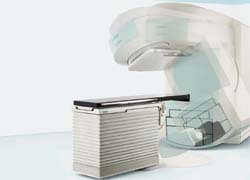Image-guided radiation therapy
Artiste takes centre stage for debut clinical use
Artiste is a linear accelerator and CT scanner combined. At the German Cancer Research Centre, a team of scientists led by Professors Wolfgang Schlegel and Uwe Oelfke of the Medical Physics in Radiation Oncology division, contributed substantially to the technical development of the Artiste platform. They report that users will be able to observe and correct the actual position, extension and potential movements of a tumour during radiation therapy.

The first Artiste system, produced and marketed by Siemens Healthcare, has now been installed at the Centre and is ready for its first actual cancer treatment. ‘The patient is suffering from an inoperable oesophagus tumour; the treatment demands very complicated radiotherapy approach,’ explained Professor Peter Huber MD, head of Radiation Oncology in the Clinical Cooperation Unit. ‘To achieve the clinically required accuracy we must determine the actual position of the tumour prior to each of the 30 fractions with the utmost precision.’ Anatomically this is necessary because the tumour shifts daily according to the stomach content. ‘With today’s treatment technology we can aim at the tumour with millimetre accuracy; however, this enormous potential can hardly be used if the tumour has moved significantly from the position determined at the time of diagnosis,’ he pointed out. Using Artiste, an observed shift in the target position can be automatically corrected while the tumour still receives the required clinical dose and surrounding healthy tissue is spared from radiation.
Further so-called adaptive therapy approaches are currently under investigation at the German Cancer Research Centre. Artiste will hopefully help to track the movement of lung or intestinal tumours so that physicians will be able to initiate radiation therapy after determination that the tumour is located at the pre-calculated position.
30.04.2008











